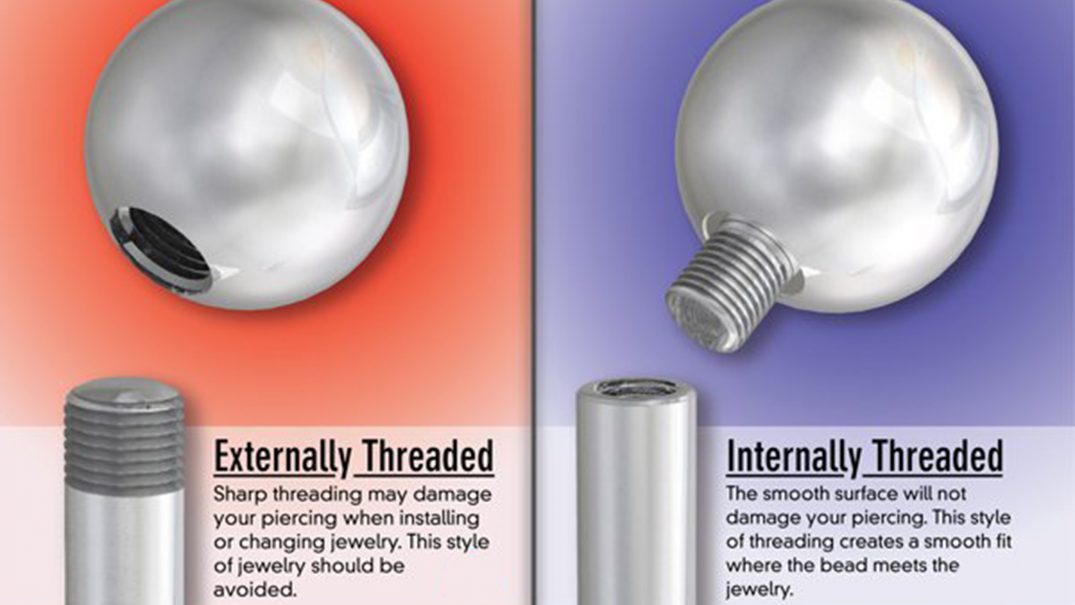Legally in the State of Ohio, all clients, including minors need some form of identification.
FOR PIERCING MINORS:
- Minors must also have proper I.D. for themselves, in addition to a present, legal guardian and their I.D.
- If the minor does not have a government issued I.D., photo ID like a school I.D or yearbook accompanied by a birth certificate is accepted.
- Legal guardian must be present, no exceptions.
- Bring state issued photo ID, such as a drivers license, military ID, or passport. It is Ohio State Law; we cannot perform services on anyone without a copy of their ID on file.
FOR DOCUMENTATION REQUIREMENTS FOR CHILDREN’S EAR PIERCINGS – CLICK HERE - Eat something substantial an hour or two before getting pierced. This will help support your blood sugar level.
- Avoid alcohol, aspirin, excessive caffeine, and all recreational drugs for 24 hours beforehand.
- Little ones are welcome to bring in a small plush toy if they are nervous about the procedure.
- Due to how small our procedure rooms are, no extra guests are allowed including children. Otherwise you must bring another adult to supervise the extra child while the minor and their legal guardian/parent are in the piercing room.
- Practice deep breathing techniques – long, slow breathes in through your nose and out through your mouth. Working on relaxing, and calming down prior to the piercing procedure will help make the piercing experience much more pleasant!
Please ensure to do all of the listed above before seeing us. We look forward to seeing you for your next piercing experience!
There are some age requirements that we like to see for specific piercings; due to our insurance liability. Please see the list below for what ages we like to see for specific piercings.
- Ear Lobe – 7 Years Old
(For more information on the reasoning for this, please visit the “Children’s Ear Piercing” Section) - Ear Cartilage (Helix) – 13 Years Old
- Daith, Tragus, Rook, Conch, Forward Helix, Navel, Nostril, Septum and Eyebrow – 14-15 Years Old
- Tongue, Lip, Labret, Monroe, Anti-tragus, Snug, Industrial – 16 Years Old
- Surface Bars and Anchors – 18 Years Old (NO EXCEPTIONS)
- Nipples and Genital Piercings – 18 Years Old (NO EXCEPTIONS)
True infections are typically quite rare when it comes to piercings.
If you do develop a little bump on your piercing; it isn’t necessarily an infection or a keloid. Keloids are typically misnomers for irritation bumps, and are usually quite rare unless you are genetically prone to them. Doctors would also have to diagnose them, along with infections. Typically what this bump means is there is a source of irritation that you need to eliminate from your lifestyle or aftercare routine, in order to get rid of your irriation bump.
For proper, in-depth aftercare, please visit this section.
True signs on infection include the piercing site becoming very red, swollen, hot to the touch, and secreting thick, dark yellow or green fluid. If you are exhibiting these symptoms, please go to your doctor to receive antibiotics, this is something we cannot help with – the only cure would be antibiotics.
Pain is relative, and everyone experiences different levels of pain for every piercing. What one person might say is very painful, another may say they barely felt anything.
However, most piercings are a bit of pressure, followed by a slight pinch for a second. Most of our clients leave the studio saying “it was so much easier than I expected!”
At Piercology, your health and safety is our priority.
We use aseptic technique which means: We use fresh gloves for every piercing, and you will see us change gloves a minimum of 3 times during your visit to prevent cross-contamination.
We use a new, sterilized needle for every client.
You get to see the package opened in front of you, and the needle disposed of immediately afterward. All tools and instruments that are not disposable, such as forceps and tubes, are thoroughly cleaned, disinfected and autoclave sterilized before use on each client.
All jewelry is ultrasonically cleaned, individually packaged, and autoclave sterilized before insertion into any new piercing.
Jewelry that cannot be sterilized (i.e. acrylic, bone, wood) is never inserted into a new piercing and is thoroughly disinfected before being inserted into a healed piercing.
We perform all of our piercings with single use, sterilized, tribevel, surgical needles. They are extremely sharp, therefore making the piercing as painless as possible. You get to watch us break open the needle package, and dispose of the needle immediately after the procedure.
An autoclave is the same device used by hospitals, doctors and dentists to sterilize their equipment. Autoclave sterilization is the only way to ensure that all equipment is properly sterilized and safe to use on you. Autoclaves achieve sterilization through the use of intense steam, heat, and pressure over an extended period of time.
Items such as dry heat sterilizers, chemical solutions, boiling and alcohol do not achieve appropriate levels of sterilization. Any autoclave being used for piercing should be tested by an independent lab at least monthly. This is called spore testing.
At Piercology, we spore test weekly on all three of our autoclaves.
The following are the metals safe for initial piercings:
- Implant-grade stainless steel: 316L or 316LVM (ASTM F-138)
- Implant-grade titanium: 6AI4V ELI (ASTM F-136)
- Niobium
- 14k or 18k solid gold (no plated gold)
All jewelry must be free of scratches, nicks, burrs and polishing compounds. Threaded jewelry must be internally threaded. You can read more on this in the Jewelry Section of our site.

Internally threaded jewelry has the threading attached to the ball, with a hole in the shaft of the barbell. Whereas, externally threaded jewelry has a hole in the ball and the threads exposed on the shaft of the barbell.
What this difference means to a piercing is that when the threads are exposed, as on externally threaded jewelry, those sharp threads can cause tears to the inside of a piercing. This can lead to pain, irritation, bleeding, scarring and prolonged healing. The quality of externally threaded jewelry is generally inferior, specifically, the finish is duller. The steel is usually a lesser grade, and in the case of curved barbells, is not shaped correctly.
When inserting internally threaded jewelry, the threads are inside the shaft, and therefore the transition from needle to jewelry is painless, with no harm done to the piercing. This means faster healing time, less chance of excessive scar tissue, and happier clients.
So why does externally threaded body jewelry exist? Because it’s much cheaper to make, and therefore your piercer makes more money off of it, but at your expense. You should never use anything less than implant grade, internally threaded jewelry in your piercings.
Will I Be Able to Get Pierced if I Am Breastfeeding?
We will not pierce you if you are currently breastfeeding. This is because although rare, there is a small chance of infection being passed through breast milk onto your infant, who has very little to no immune system to fight off said infection.
As well, your body is still going through postpartum hormonal changes after birth, and for several months after giving birth. This already puts a strain on your immune system, and adding healing a piercing to that, can cause the piercing not to heal well. We want what is best for you, so please intend on being pierced once you finish breast feeding.
Will I Be Able to Breastfeed After Getting my Nipples Pierced?
If pierced properly, having your nipples pierced will not impede you from breastfeeding. However, you want to make sure your piercings are well healed beforehand. Also, be sure to remove your jewelry before breastfeeding, as it can be a choking hazard for infants.
For ear lobe piercings, it is a good idea to avoid swimming for the first 6-8 weeks until the inital healing process is complete. For cartilage and other piercings that take longer to heal; we recommend waiting at least 3 months before swimming.
Unless you can cover your piercing with a Tegaderm patch bandage. This is a clear, adhesive, water-proof bandage that can be comfortably worn on some piercings, such as navels with curved barbells, and nipples. It can usually be found at most pharmacies. Of course, if it’s a facial piercing, just avoid submerging it.
We do not recommend placing a bandage on your piercing, as the adhesive can irritate the piercing site. If you do decide to place a bandage over top of your piercing, please ensure the padding is only touching the jewelry, and the adhesive does not touch the piercing site. A band-aid will not help the piercing heal faster – in fact, it may actually prolong your healing period.
There are several reasons why we do not use piercing guns for any type of piercing.
First, there is no way to sterilize piercing guns. Most guns are made of plastic and will melt under the extreme heat and pressure of an autoclave (the piece of equipment used to sterilize implements) and chemical sterilization has not been proven to kill all blood borne pathogens. This is extremely dangerous since fluid micro-spray (microscopic particles of tissue, blood and other body fluids) might be present on the gun after a piercing.
Second, piercing guns are considerably more painful than a piercing needle because you are essentially forcing a blunt object through flesh – which tears the skin, traumatizes the area, and causes excess swelling and can complicate healing.
Third, since both the instrument and the jewelry were designed for earlobes, they are not compatible with other areas of the body, increasing the risk of infection and further complicating the healing process.
Fourth, standard piercing gun jewelry are made of a poor quality metal that can cause additional complications such as allergic reaction.
Lastly, the jewelry is poorly designed in that the backing traps and collects waste, hair and debris, holding it against or close to the piercing. This is far from an ideal healing environment.
Tips are never expected, but always appreciated. Piercing is a service and if you were happy with the service you received, yes tipping is appropriate.
How Much Should I Tip?
Obviously, any amount is appreciated, but most people tend to tip between 15-20%. Any and all tips are appreciated!
Licensed & Established
We are founding members of the Ohio-based Association of Body Art Professionals.
Trained Professionals
All of our piercers go through extensive training to ensure your health and safety.
Sterilized Equipment
We perform weekly testing on all sterilization equipment and ensure cleanliness.

